#sandstone rocks rise
Explore tagged Tumblr posts
Photo

2024 July 29
Milky Way over Uluru Image Credit & Copyright: Max Inwood
Explanation: What's happening above Uluru? A United Nations World Heritage Site, Uluru is an extraordinary 350-meter high mountain in central Australia that rises sharply from nearly flat surroundings. Composed of sandstone, Uluru has slowly formed over the past 300 million years as softer rock eroded away. The Uluru region has been a home to humans for over 22,000 years. Recorded last month, the starry sky above Uluru includes the central band of our Milky Way galaxy, complete with complex dark filaments of dust, bright red emission nebulas, and billions of stars.
∞ Source: apod.nasa.gov/apod/ap240729.html
169 notes
·
View notes
Photo

Milky Way over Uluru, 2024-07-29
What's happening above Uluru? A United Nations World Heritage Site, Uluru is an extraordinary 350-meter high mountain in central Australia that rises sharply from nearly flat surroundings. Composed of sandstone, Uluru has slowly formed over the past 300 million years as softer rock eroded away. The Uluru region has been a home to humans for over 22,000 years. Recorded last month, the starry sky above Uluru includes the central band of our Milky Way galaxy, complete with complex dark filaments of dust, bright red emission nebulas, and billions of stars.
Credits: NASA's 'Astronomy Picture Of The Day.'
80 notes
·
View notes
Text
everybody talks about aquifers like theyre normal. but aquifers are weird. the ground is full of water. and apparently weve known about this shit since like forever.

Artesian aquifer scheme:
Aquifer
Impervious strata
Infiltration area
Artesian well
Saturation level
Subartesian well
Artesian spring
An artesian well is a well that brings groundwater to the surface without pumping because it is under pressure within a body of rock and/or sediment known as an aquifer.[1] When trapped water in an aquifer is surrounded by layers of impermeable rock or clay, which apply positive pressure to the water, it is known as an artesian aquifer.[1] If a well were to be sunk into an artesian aquifer, water in the well-pipe would rise to a height corresponding to the point where hydrostatic equilibrium is reached.[1]
The first mechanically accurate explanation for artesian wells was given by Al-Biruni.
1000 years of knowing about the rocks...

The Great Artesian Basin (GAB)[1] of Australia is the largest and deepest artesian basin in the world, extending over 1,700,000 square kilometres (660,000 sq mi). Measured water temperatures range from 30 to 100 °C (86 to 212 °F). The basin provides the only source of fresh water through much of inland Australia.[2]
Most recharge water enters the rock formations from relatively high ground near the eastern edge of the basin (in Queensland and New South Wales) and very gradually flows toward the south and west.[6] A much smaller amount enters along the western margin in arid central Australia, flowing to the south and east through the permeable sandstone, at a rate of one to five metres per year.
Discharge water eventually exits through a number of springs and seeps, mostly in the southern part of the basin. The age of the groundwater, determined by carbon-14 and chlorine-36 measurements combined with hydraulic modelling, ranges from several thousand years for the recharge areas in the north to nearly 2 million years in the south-western discharge zones.[7]
the earth provides....
also, ive mentioned qanats on here before but there are nearly 3000 year old underground aqueducts in iran. i mean. i guess its not that crazy like you just dig a tunnel and mining is super old. but still
38 notes
·
View notes
Text
Бирюзовая Катунь достопримичательность Горного Алтая.
Turquoise Katun is a landmark of the Altai Mountains.

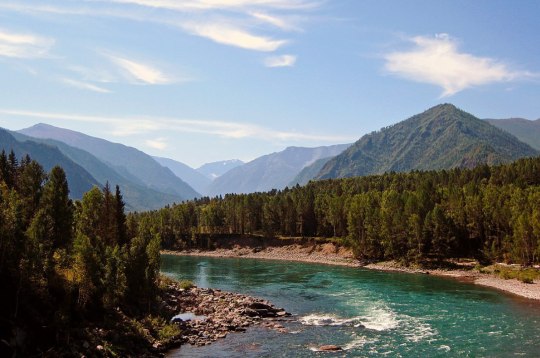

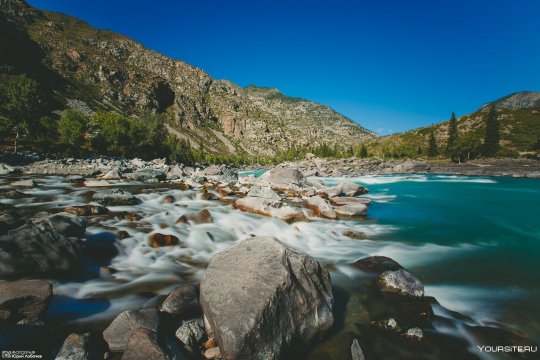
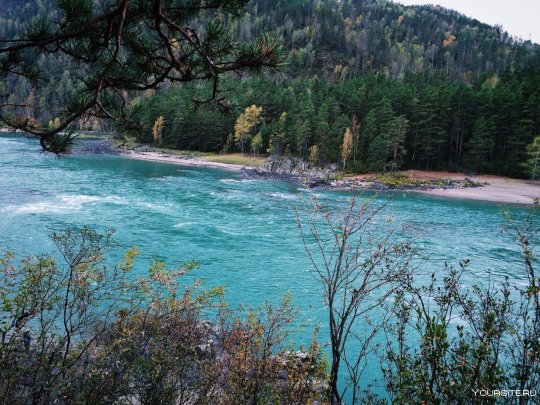


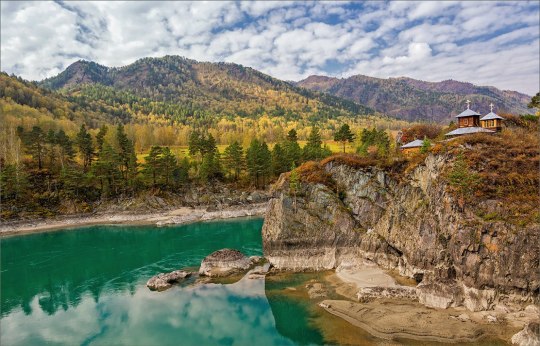
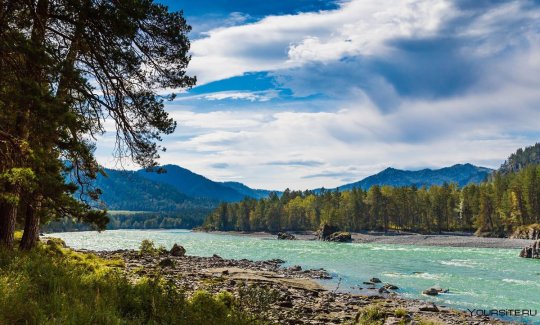
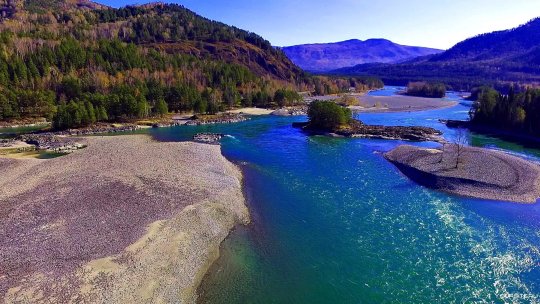
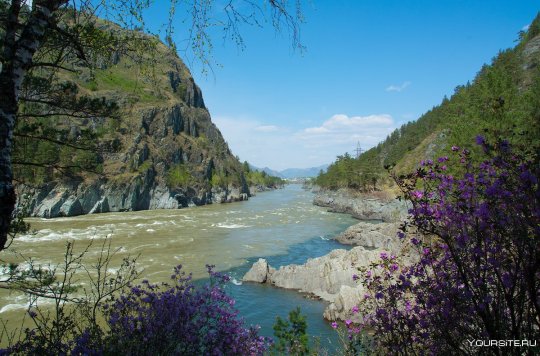
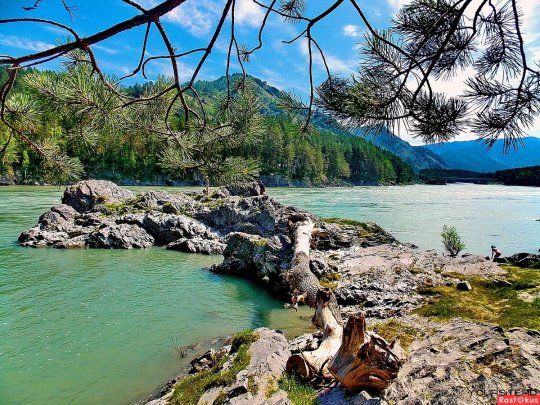

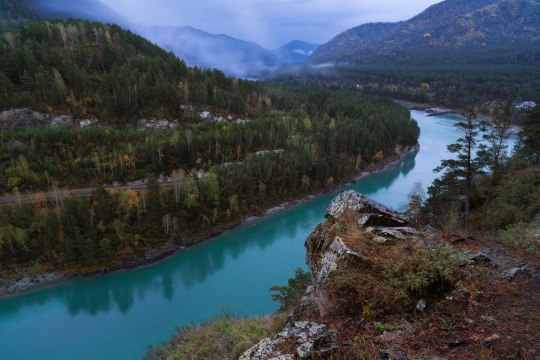
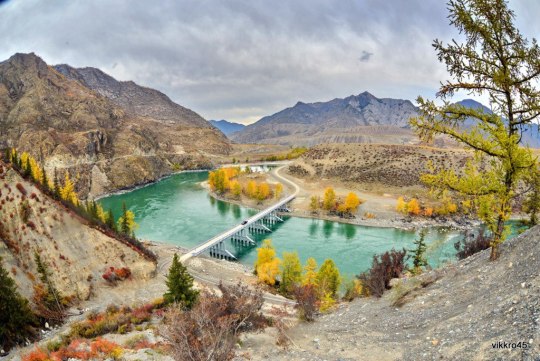


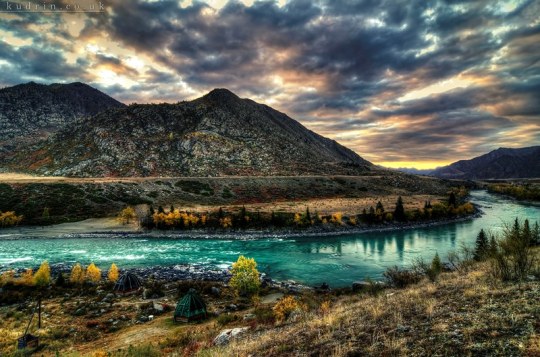
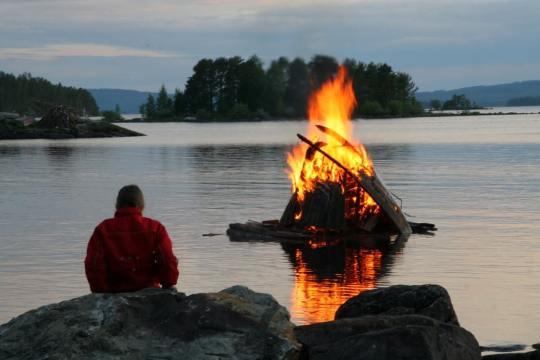


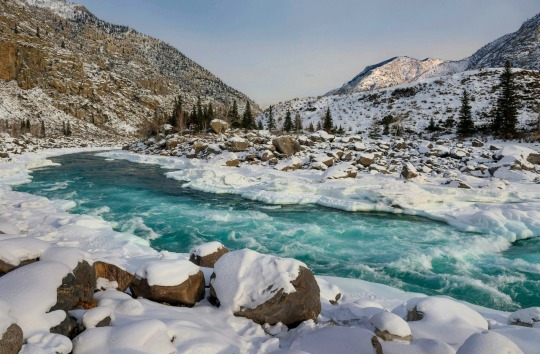


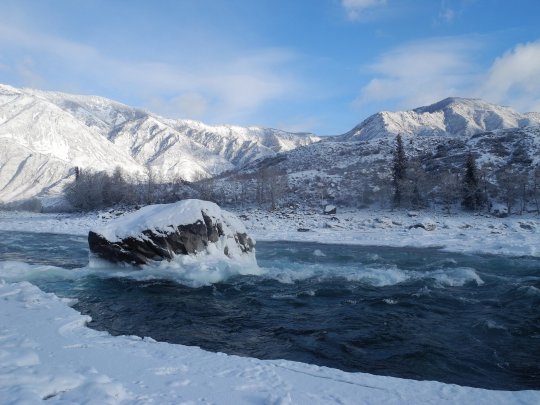
Самая длинная и полноводная в Горном Алтае река Катунь начинается с ледника Геблера у подножия Белухи, и заканчивается в месте слияния с Бией и впадения в Обь. Протяженность — 668 километров. Вода всегда холодная, в жаркие дни ее температура поднимается до 15 градусов.
Особенностью этой реки считают смену цвета в течение года. Так в весенний и летний периоды воды имеют грязный молочный оттенок, что связывают с примесью мелкой породы из-под ледников, питающих реку. Осенью же вода становится прозрачной с бирюзовым оттенком из-за зелено-каменных включений от песчанников в верхнем и среднем участках Катуни. Самая прозрачная, чистая и бирюзовая вода в реке бывает зимой. Большая часть реки зимой замерзает, но на порогах бурные воды Катуни выдерживают серьёзные морозы.
Место слияния Катуни и реки Бии славится своей красотой. Это связанно с тем, что воды Катуни имеют зеленоватый или бирюзовый цвет, а Бии — белый. Смешение воды в летнее время на определенном участке не происходит и выглядит как «полосатое течение». В месте впадения одной реки в другую расположен остров, который носит статус особо охраняемой природной территории.Также месту слияния рек придают мистическое значение старообрядцы, cчитая, что именно здесь состоится последняя битва добра и зла.
The longest and deepest river in the Altai Mountains, the Katun River, begins from the Gebler glacier at the foot of Belukha, and ends at the confluence with the Biya and the confluence with the Ob. Length - 668 kilometers. The water is always cold; on hot days its temperature rises to 15 degrees.
The peculiarity of this river is the change of color throughout the year. Thus, in the spring and summer, the waters have a dirty, milky tint, which is associated with the admixture of small rock from under the glaciers that feed the river. In autumn, the water becomes clear with a turquoise tint due to green-stone inclusions from sandstones in the upper and middle sections of the Katun. The most transparent, clean and turquoise water in the Katun River occurs in winter. Most of the river freezes in winter, but the rapids can withstand severe frosts.
The confluence of the Katun and the Biya River is famous for its beauty. This is due to the fact that the waters of the Katun are greenish or turquoise, and the Biya is white. Mixing of water in the summer does not occur in a certain area and looks like a “striped current”. At the confluence of one river and another there is an island, which has the status of a specially protected natural area. Old Believers also attach mystical significance to the confluence of rivers, believing that this is where the last battle of good and evil will take place.
Источник://itonga.ru/russia/reka-katun/,
//usadba2.ru/look/reka-katun-legendy-i-krasoty-gornoy-reki,
//sportishka.com/turizm/17422-golubaja-katun-gornyj-altaj.html,
/www.vpoxod.ru/page/toponym/katun,
/akkem-tur.ru/stati/reki-altaya/reka-katun/, http://www.sayanring.ru/guide/city/view/44/.
#Russia#Altai#Katun river#nature#nature aesthetic#landscape photography#mountains#river#bridge#trees and forest#winter river#snow#wooden church#travel#bonfire#wonderful#Россия#Алтай#природа#река#Катунь#Пейзаж#горы#лес#зимняя река#снег#небо#церковь#мост#костер
141 notes
·
View notes
Text
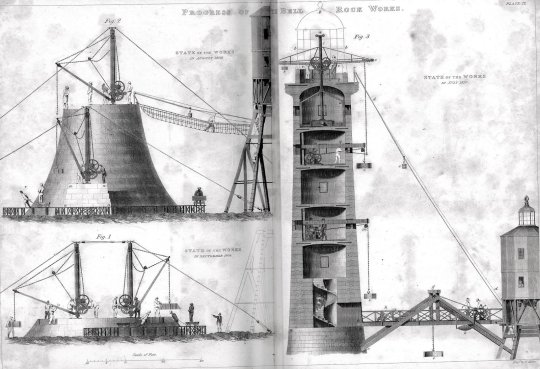


The Bell Rock Lighthouse, off the coast of Angus, was first lit on the 1st of February 1811.
Over 200 years after it was first built, the Bell Rock Lighthouse still stands - proudly flashing its warning light. Eleven miles out to sea off the east coast of Scotland, it is a remarkable sight - a white stone tower over 30m (100ft) high, rising seemingly without support out of the North Sea.
In fact, it is precariously poised on a treacherous sandstone reef, which, except at low tides, lies submerged just beneath the waves.
The treacherous reef on which it stands is in the North Sea, between the Firths of Forth and Tay, some 12 miles south of Arbroath and 14 miles south east of St Andrews. The red sandstone outcrop is 435m long and the lighthouse is founded on the main section, 130m long and 70m wide, and only 1.2m above the surface at low water spring tide.
The reef was known originally as Inchcape Rock or Cape Rock. According to tradition, in the 14th century the Abbot of Aberbrothok (Arbroath) placed a floating bell on it to warn mariners, hence its present name. Legend has it that sometime later a Dutch pirate removed the bell but he was later shipwrecked and perished on the same reef. The rocks were dangerous to ships sailing along the east coast of Scotland and by the end of the 18th century the need for a lighthouse was clear.
A severe storm in December 1799, in which about 70 vessels were wrecked, prompted Stevenson to propose a beacon-style lighthouse on six cast iron pillars.
Stevenson submitted a scale model of his idea to the Northern Lighthouse Board in summer 1800 — accurate physical modelling was to become something he often employed subsequently on important projects.
Stevenson drew the inspiration for his lighthouse design from the Eddystone Lighthouse, off the coast of Cornwall.
Built 50 years earlier by John Smeaton, this was a milestone in lighthouse design. Shaped with the now classic wide base, tapering to a narrow tower (Smeaton had modelled it on an oak tree he had witnessed defying a storm), it was the only off-shore structure that had until then managed to survive for any length of time against the constant battering of the seas.
Stevenson elaborated on this design. His lighthouse would have to be higher, over 30m (100ft), if it was to survive the cruel waves of the North Sea. He also incorporated more efficient reflectors, using the latest oil lighting technology, which would make his beacon the brightest yet seen.
But the Northern Lighthouse Board rejected the plan outright; in their eyes Stevenson was attempting the impossible, and besides, it was going to cost the huge sum of £42,685 and 8 shillings.
The rock had to claim another victim before the Board revisited Stevenson's plans. In 1804 the huge 64-gun HMS York was ripped apart on the rock, with the loss of all 491 crew. The NLB could delay no longer. Britain's most eminent engineer, John Rennie, was invited to give his advice.
Rennie had never actually built a lighthouse, but the Board was so impressed by his record that he was given the job of chief engineer. Robert Stevenson was to work as his resident engineer.
History does not record Stevenson's reaction to the news, but it must have come as a bitter blow to this ambitious young man. What history does record is that the structure on Bell Rock came to be known not as Rennie's but as Stevenson's Lighthouse.
Work started in 1807 and what followed was a four-year epic, with work severely restricted by tides that on occasion submerged the rock’s surface to twelve feet. The offshore activity only proceed during the summer months, and even then only with difficulty. Poor weather in the summer of 1808 allowed only 80 hours of work were completed.
To avoid time lost in shuttling workers to and fro Stevenson built a temporary wooden “Beacon House” on the rock and this served as both a base of operations and living quarters for fifteen men. As this structure (see illustrations) was also exposed to storms during the construction period, residence on it must have in itself have been a nightmare. During the winter months Stevenson kept his crews busy ashore, dressing the individual granite blocks needed for the tower. The total number required was some 2500 and all were drawn to the dockside by one of the unsung heroes of the project, a horse called Bassey.
The lighthouse came into service in 1810 and was to fulfil its purpose very effectively. Between then and 1914 only a single ship was lost on the rock, a steamer called the Rosecraig that ran aground during a fog in 1908, fortunately without loss of life.
The light has now operated for 212 years and has undergone many significant and ingenious upgrades and changes, some of them even being undertaken by non-Stevenson engineers. It was a manned light for 177 years, the lives of those keepers on their temporary Alcatraz being a source of equal fascination
The lighthouse was manned until 1988, when the station turned automatic and the last men were withdrawn.
53 notes
·
View notes
Text
Waiting for the Storm
Prologue
Series Masterlist Chapter 1
pairing: Michael Kinsella x fem!Reader
summary: "If you spend your whole life waiting for the storm, you'll never enjoy the sunshine." -Morris West
When Michael's release day finally arrives, he isn't too optimistic about his future. The most he's hoping for is a relationship with his daughter and a new path forward. The world, however, has bigger plans for him after he meets a timid, yet lovely, children's book illustrator who has more in common with him than it seems.
warnings: swearing, emotional and physical abuse (very brief descriptions here but these will be recurring themes in this story), descriptions of prison, descriptions of family loss
a/n: Ahhhh! My first Mikey story because I FINALLY had inspiration. I am way too excited about this WIP so I really hope this lil tidbit gets y'all intrigued! The general vibes will be fluff and hurt/comfort because Mikey deserves to be comforted. I hope you all enjoy!
w/c: ~900
There was something comforting about the rain. Peaceful and cleansing. Water vapor rising unburdened by the impurities of the ground to the heavens and falling back again like a gift, washing away the sins below with every splattering drop.
When she was a child, the other girls bemoaned their hometown’s climate and constant precipitation. “Rain brings noise, and floods, and mud, and worms!” They’d lament to her after every storm. She never knew how to tell them that none of those consequences bothered her.
Floods were rare, and more a symptom of poor drainage systems than the rain itself. Mud was mostly avoidable, and easy to wash away. Worms were necessary for composting and agriculture, not to mention completely harmless.
The noise, well, this she understood. When she was a toddler the loud smashes of thunder and cracks of lightning terrified her too—scaring her under the covers night after night, hands clamped over her ears. But then her life became less quiet, and the storms were less loud by comparison.
See when your home is full of screaming, and crying, and the echoing slap of skin hitting skin, thunder is a lot more appealing. It’s easy to focus on. If you try hard enough, you can let it drown out the sounds of your father putting another hole in the drywall, of your mother’s car pulling out of the driveway for the last time—the tires screeching as she leaves you behind.
The spattering of rain against the windows became her anchor whenever the universe was kind enough to offer it to her. When her father rages around the house, destroying every trace of his estranged wife, she would lay in bed—eyes glued to the droplets splashing against the glass.
On the especially bad nights, she pictured a safe haven: a set of cliffs, composed of worn shale threaded with lush green grass. She could feel the cracked sandstone through the fabric of her pajamas as she sat along the edge. Fat raindrops drenched her scalp, trailing down her face, over her heavy eyelids and exposed collar bone. The ground beneath her grew increasingly damp, each swirl of water wafting the scent of petrichor towards her nose. Somewhere in the distance, waves crested over rocks—the sound getting lost in the patter of the rain.
As she aged, she continued to dream of this place. Throughout her tumultuous teenage years and every disagreement with her father. Each and every time she felt lonely after moving to another, sunnier, state for her bachelor’s degree.
The image was especially helpful as her relationship with Xavier turned sour. Every insult, threat, and smack fading into the drum of raindrops on rock. She’d lay awake at night, bruises blooming on her limbs, imagining the rain.
And it was the steady pounding of droplets on the roof that gave her the courage to pack her things and leave. Trekking across town, over multiple bus routes, until she stood her friendly coworker’s doorstep—soaked to the bone, and more unhurried than she’d been in years, all thanks to the rain.

Michael had never minded the rain. A symptom of living in Dublin his whole life, he supposed. When every other day brought a shield of clouds over the sun, you adjusted or you fled to brighter pastures.
He sure as hell didn’t mind it when he was in his cell, listening to the jeers and yelling of the other prisoners night after fucking night. The thrum of raindrops against cinderblock were a welcomed static noise.
At first, he was grateful for the solitude of his protected status. It gave him time to grieve the loss of his wife, to repent for his hand in her death. His stint in prison meant he was temporarily relieved of the burden placed on his shoulders by the family and it gave him time to grow and reflect.
But it also meant losing Anna, grieving and spiraling on his own for eight excruciating years, and being closer to his father than he’d ever wanted to be again. It meant that he’d lost everything that mattered, because he’d been too careless to protect it.
He missed freedom. He missed his family, his daughter more than anything. He missed fresh air, and hot water, and home cooked meals. He wanted to feel the wind against his chest, the rain on his face, anything but the stale breath of hundreds of other prisoners and the bite of the cool cement against his back as he drifted off.
His release day approached slowly, at first. But after the first few years, the days began to blend together. Seasons rolling by like a strip of film in a projector, bursts of green coming and going as the plants in the sparse outdoor yard sprouted and died. The tunnel was quickly ending, but he wasn’t yet sure if there was light at the end of it.
Regardless of what lay waiting for him outside of those gates, he’d regain his autonomy, he’d try to see Anna, he’d try to move forward.
This is what the rain sounded like, when it pounded against the foundation of the prison. It sounded like liberty, like family, like achievable peace.
If he could feel the rain again, he could keep going. And he would.
#michael kinsella#michael kinsella x reader#michael kinsella x you#mikey kinsella#kin rte#kin amc#kin bbc#charlie cox#mk#my writing#WFTS
26 notes
·
View notes
Text
VESSEL VESPER
A Star Wars Story
The rise of the empire is a difficult time to find funding for environmental research at the University of Rudrig. The Vesper Science Crew is in a unique standing to be able to conduct their research with “generous” government grants. Professor Munnin and her intern, Fern Vulez, spend their field season collecting important data on the ecological effects of a relentless galaxy-crossing war. While the small team are a good match of skills, their frequent personality conflicts put a heavy strain on morale.
CW: nothing outside of Star Wars canon-standard peril.
WC: 1297
Chapter 1: STUNNED

The relentless canyon wind flew by at a blistering pace. Frantic like a creature pursued by a predator. The gusts battering the ears of two figures standing at the southern rim. Below, the crevasse yawned out, widening to the West. What would have been a mighty river below, was reduced to a fine silver trickle bordered by mud and rock.
“Looks sticky down there.” Fern lowered his binoculars and pulled his hood tight over his ears, burning with cold. His dark eyes shifted nervously at the landscape below, trying to map a safe place to conduct their sampling. His black hair whipped across his cheekbones with ferocity.
His boss still had her eye to the scope of her rifle. The Fosh’s voluminous head of black feathers flashed green iridescence as the wind battered them. A sigh escaped her long beak. “Doesn’t look like there is a single solid place to land the ship down there.”
Fern braced himself for what that meant.
“You’ll have to climb down there, scout out a place where our setup isn’t going to sink.” Professor Munnin lowered the scope and replaced her round glasses on her beak.
Fern opened his mouth to protest.
Motti cut him off “I know I’m lighter than you and would do better on the mud, but I’m also a better shot than you and would be more useful covering you from up here.”
“With all due respect, Professor. The basin looks deserted, what do you need to cover me from?”
Motti hesitated, then raised her scope again, letting it push up her spectacles.
“Glass up degrees 148, -42.”
Fern did so, raising his binoculars once again, and took a second for his eyes to adjust to what he was supposed to be looking at. Huge short toed tracks on the far bank. Sinking FAR into the mud. Something very heavy.
He groaned, “Fine, but you owe me.”
Fern was relieved to find that the canyon walls were sandstone, extremely grippy and easy to climb down. The wind was much more tolerable now that he was between two shoulders of rock. He had always been light footed, enjoying some casual freerunning and climbing in his free time (of which he had very little of since he started working for the Professor). His flexible leather boots made his footsteps nearly silent, though the wind masked his audible presence well enough.
Motti regained visual on her intern. Switching from her scope to her naked eye every now again, studiously surveying the entire basin. She raised her comm “Made it down okay?”
“Aww, you do care!” Fern remarked sarcastically.
“Yeah, well, imagine all the paperwork I’d have to do if I sent you to your death.”
“HA. Well the climb was the easy part, this mud is VERY soft.” Fern was already knee deep in the stuff. Progress suddenly became painfully slow.
Once he had made it farther out into the open, the mud was not quite as bad. He brought out his datapad to more carefully analyze the ground density around him.
“Is it possible to set up in the water? Doesn’t look to be that deep, and there’s no mud there. Just rocks.” Fern cupped his hand around his comm as he spoke and looked up at the little dot of a figure on the rim, shielding his eyes from the sun. L
“We can try it. Do you think we could land the Vesper there?”
“Let me get closer.” Fern continued on, one mud sucking footstep at a time, until he made it to the water’s edge.
“It’s only about, I don’t know, a half meter deep here? It’s a nice flat riffle, gets a little deeper downstream.”
“It might be a tight squeeze… let me get the rangefinder. I’ll be right back.” Motti pocketed her comm and swung her rifle over her thin feathered shoulder. She hopped up on her clawed feet and trotted back toward the ship.
Fern took a moment to take in the nature around him. Mud aside, it was a nice little spot. Tall seeding grasses dotted the shoreline, short stubby trees lined a perimeter parallel to the river, following some perfect vein of suitable soil invisible to him.
Rainbow-winged insects flitted on the surface of the water, and several aquatic creatures he couldn’t make out sipped them out of the sky for a tasty treat. He kicked a bit at the water, letting the current clean his legs now caked with dry mud.
Splash, splash. The water around him changed to brown and his boots instantly looked like new. Splash splash. More splashing noises, but he had stopped moving. He raised his gaze upstream.
SPLASH SPLASH SPLASH. From behind a boulder, a dark furred shape came in to view one mammoth step at a time.
Fern froze with fear, the sheer immensity of the beast turning his whole body into fight or flight mode. Regardless if this creature was friendly or not, its imposing stature was enough to send his heart racing and hands shaking.
It didn’t seem to notice him yet, but that was no consolation. There was absolutely nowhere for Fern to go, besides downriver. Getting stuck in the mud with this thing about seemed like a sure way to get trampled.
“BZZZT…. He– –ern did you…” Fern’s heart dropped at the sound of his comm. He reached for it as quickly as he could to turn it off. “... put t– —---gefinder in the aft s—---ge compartment again?” Motti’s voice came in choppy as she was out of line of sight. Fern got the comm off and looked up. The beast’s head was high, its single horn above its nose pointed straight in the air. Beady eyes surveying, gaping nostrils flaring. No way that thing could get a scent with that backwind, but that didn’t make him any less trapped.
-
No reply on the comm. Nothing is ever put back where it belongs on this ship. Motti muttered to herself. Knowing full well that she was probably the one to misplace the rangefinder. She rounded to the exterior storage door when her comm started pinging red, emergency mode. Of course she can’t leave her intern at the bottom of a canyon for FIVE MINUTES without him getting into trouble.
-
When Motti skidded to a stop at the canyon rim she scanned for movement below. Right away she noticed the hulking furred shape standing in the water, a mudhorn. Not native to this planet, where had it come from? This was going to be a significant data point in her Intraplanetary Watershed Species Composition Matrix. Her thoughts snapped out of analysis mode when she noticed a much smaller figure facing the Mudhorn. Fern.
She raised her rifle scope to her beady golden eye. Don’t move, please don’t move fern… She begged internally.
Taking out this beast was the right thing to do, for ecology’s sake, and for saving Fern’s life of course. She leveled her crosshairs toward the beast’s cranium, internally referencing her studies on mammalian skulls to picture the exact spot where the Mudhorn’s tiny brain rested within it’s enormous head. Her scaly finger began to squeeze the trigger when the beast jolted forward, and was out of her sight.
NO! Fern was running, and the beast gave chase. The foolish human would never outrun the beast. There was only one thing Motti could do from her high perch, and she had to get it perfect. Her fingers worked quickly, setting the rifle to “stun”. She set the crosshairs now on the frantic intern, bounding his way down the shallow river, his data pad bouncing along behind him on its bungee cord. He was covering a surprising amount of ground, but still not enough to outrun a Mudhorn.
She squeezed the trigger.

Taglist: @stars-n-spice
Authors notes:
AAA I started writing this so long ago it feels great to put it out there! This is going to lead in to Ulvi and Flinch’s story soon. I have big arcs planned for each character, so there isn’t really a central main. They’re all going to be more or less equally featured. Sort of like a D&D campaign type of pacing.
Honestly I have @stars-n-spice to thank for having so much enthusiasm for my OCs when we first interacted! It absolutely led me to post this :)
Happy to put anyone on the Taglist just lmk. Cautiously optimistic that I’ll keep working on this for a long time!
Also Motti is voiced by Sigourney Weaver that’s my canon 😆
#vessel vesper#vesper science crew#my OCs#my writing#star wars fanfiction#star wars#motti Munnin#fern vulez
15 notes
·
View notes
Text
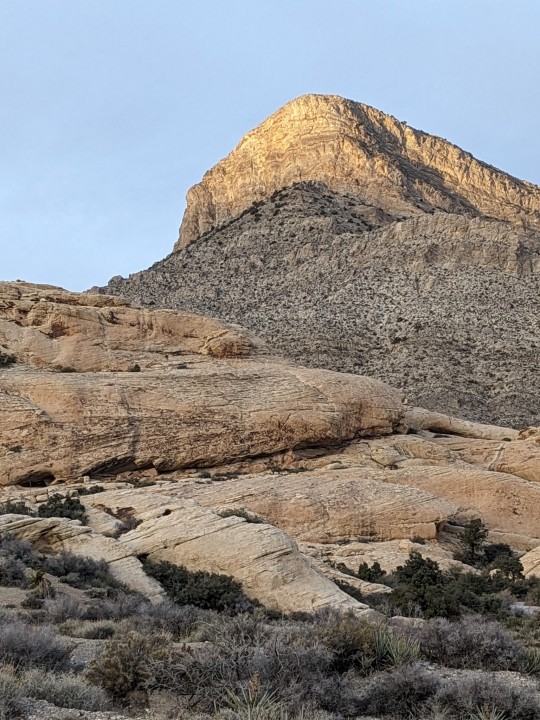

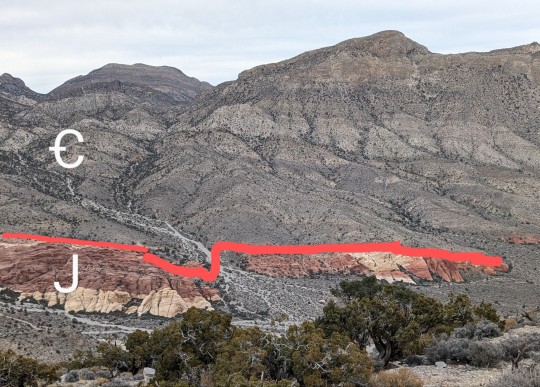
The sea lies over the desert here
These ancient blocks of stone
Rise from depths hidden down beneath
The valley far below
Once this ocean had dried away
Til it was naught but sand
Now it returns as rain unto this
Dry and dusty land
I stand on oceans, mountaintops,
I stand on desert dunes
I stand on both because what was
Is now in different tune
--------------------------------------------
The Keystone Fault, as outcropping at Turtlehead Mountain in Red Rock Canyon, Las Vegas NV.
Cambrian cliffs of Limestone now overlie Jurassic sandstones here due to the tectonic shuffle of the Sevier orogeny in this region. Absolutely beautiful.
18 notes
·
View notes
Text
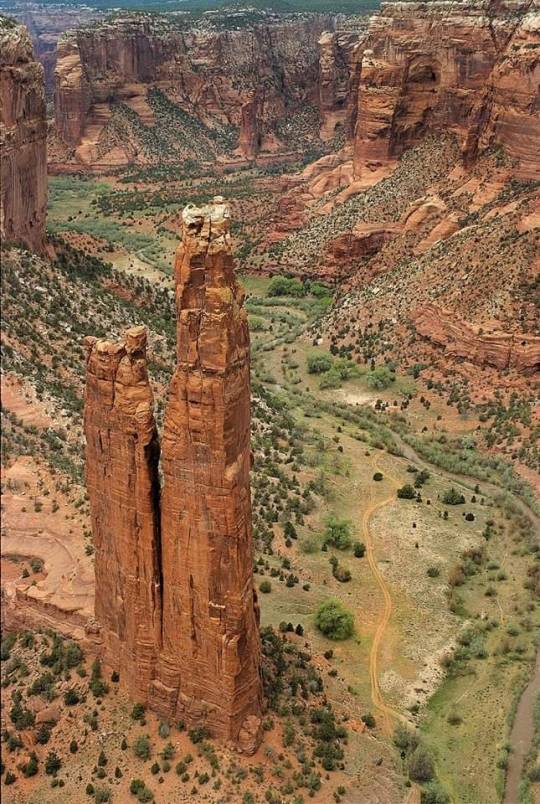
Spider Rock, Canyon de Chelly National Monument, Arizona, USA.
📷 PetevPaul Photography
The canyon's best-known feature is Spider Rock, a sandstone spire that rises more than 700 feet from the floor of the canyon. It's named for Spider Woman, a key figure in Navajo lore. Spider Rock, Pranger says, is the last remnant of stream and hillslope erosion process that continue to make the canyons deeper and wider.
Source: Beautiful Planet
71 notes
·
View notes
Note
The geological time scale (GTS), as defined by international convention,[3] depicts the large spans of time from the beginning of the Earth to the present, and its divisions chronicle some definitive events of Earth history. Earth formed around 4.54 billion years ago, approximately one-third the age of the universe, by accretion from the solar nebula.[4][5][6] Volcanic outgassing probably created the primordial atmosphere and then the ocean, but the early atmosphere contained almost no oxygen. Much of the Earth was molten because of frequent collisions with other bodies which led to extreme volcanism. While the Earth was in its earliest stage (Early Earth), a giant impact collision with a planet-sized body named Theia is thought to have formed the Moon. Over time, the Earth cooled, causing the formation of a solid crust, and allowing liquid water on the surface.
The Hadean eon represents the time before a reliable (fossil) record of life; it began with the formation of the planet and ended 4.0 billion years ago. The following Archean and Proterozoic eons produced the beginnings of life on Earth and its earliest evolution. The succeeding eon is the Phanerozoic, divided into three eras: the Palaeozoic, an era of arthropods, fishes, and the first life on land; the Mesozoic, which spanned the rise, reign, and climactic extinction of the non-avian dinosaurs; and the Cenozoic, which saw the rise of mammals. Recognizable humans emerged at most 2 million years ago, a vanishingly small period on the geological scale.
The earliest undisputed evidence of life on Earth dates at least from 3.5 billion years ago,[7][8][9] during the Eoarchean Era, after a geological crust started to solidify following the earlier molten Hadean eon. There are microbial mat fossils such as stromatolites found in 3.48 billion-year-old sandstone discovered in Western Australia.[10][11][12] Other early physical evidence of a biogenic substance is graphite in 3.7 billion-year-old metasedimentary rocks discovered in southwestern Greenland[13] as well as "remains of biotic life" found in 4.1 billion-year-old rocks in Western Australia.[14][15] According to one of the researchers, "If life arose relatively quickly on Earth … then it could be common in the universe."[14]
Photosynthetic organisms appeared between 3.2 and 2.4 billion years ago and began enriching the atmosphere with oxygen. Life remained mostly small and microscopic until about 580 million years ago, when complex multicellular life arose, developed over time, and culminated in the Cambrian Explosion about 538.8 million years ago. This sudden diversification of life forms produced most of the major phyla known today, and divided the Proterozoic Eon from the Cambrian Period of the Paleozoic Era. It is estimated that 99 percent of all species that ever lived on Earth, over five billion,[16] have gone extinct.[17][18] Estimates on the number of Earth's current species range from 10 million to 14 million,[19] of which about 1.2 million are documented, but over 86 percent have not been described.[20]
The Earth's crust has constantly changed since its formation, as has life since its first appearance. Species continue to evolve, taking on new forms, splitting into daughter species, or going extinct in the face of ever-changing physical environments. The process of plate tectonics continues to shape the Earth's continents and oceans and the life they harbor.
awesome! d'you like dinosaurs :D
5 notes
·
View notes
Text
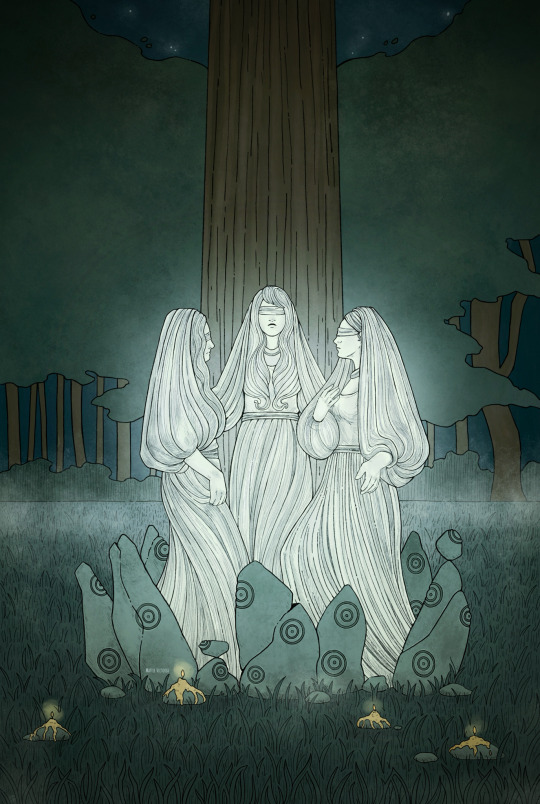
In Najran province of Saudi Arabia, carved in sandstone at the peak of a 200-meter hill facing east, is a petroglyph of a female figure. A petroglyph of a Mother Goddess that when lit by the rising sun, can be seen for miles on end. Over 4,000 miles north from Najran province, on Salisbury Plains in Wiltshire, England, one can find the world-famous Stonehenge— a circle of megaliths thought to be everything from an astronomical clock to a place of healing. Rocks and minerals are all around us, a part of common, everyday life and for time immemorial, our ancestors have prescribed them significant meaning. Since picking up rockhounding during the Pandemic as a way to get outside and still practice social distancing, I’ve become more and more interested in rock folklore which each excursion I take into some defunct mine or rock outcropping. As an artist and life-long folklore and mythology enthusiast, I’ve noticed that when it comes to nature lore, people are, in general, more interested in the lore surrounding things like trees and flowers. While I do love plant lore, the past year or so has seen me diving into the myths associated with rocks, mines and caves. I knew I needed a space to prattle on about my deep-dives, and thus the idea to write this little article was born!
First and foremost, I have to talk about the vittror (plural form of the singular vittra) a type of vættr, or nature spirit, found throughout Scandinavian folklore. I love the stories of the vættr, one of my favorite aspects of the stories being that the vittror can be found living in rocks and trees, and have the ability to harm humans who trespass into their domain. A vittersten is the name given to a boulder or rock formation that a vittra has claimed as their home. All vittror live along leylines called vittervägar, and it’s said that at the points where these leylines intersect, the veil is thinner. Supernatural happenings are more likely to occur in these spots, as well as accidents, illnesses and even death. A vittersten may lie at the intersection of one of these supernatural crossroads, and if you find yourself at such a dubious place, well… you’d best be careful. If you disturb a rock or a tree that a vittra calls home, you may find yourself with a newly-fabricated curse placed upon your person. If you find that you feel a sudden wave of nausea, a chill, or any kind of discomfort, it means you have disturbed a vittra. The best way to remedy this is to apologize to the vittra that you have offended, or leave offerings. There are stories of entire construction projects being re-routed or stopped altogether because the development of that area upset the particular vittra living there. So be careful, because you may find yourself on a hike with the need to relieve yourself behind a rock formation for some privacy… perhaps you are accidentally befouling the site a vittersten!
Another one of the more fascinating stones that have a particular folklore attached to them is the adder stone. The adder stone is a small rock with a naturally occurring hole bored completely through the center. Adder stones have a glassy quality and are usually flint, though in ancient times they were thought to be created from snake saliva, hence their name. Pliny the Elder wrote that adder stones were important to druids, and even until recent times, the adder stone has held a great importance in the British Isles. In England, they’re called Hag Stones, and in Scotland, Mare-Stanes, because it was said that whoever possessed one of these supernatural stones was immune to visits from the Mare or Hag, a vicious being that was said to sit on its victims’ chests while they sleep, causing them to have nightmares. In Scotland, Mare-Stanes were often kept near beds to prevent such night terrors, but they would also be kept on an individual’s person. They had other uses, too, such as being tied up in barns to ensure that a pregnant cow births her calf safely. One interesting story is that of a particular Mare-Stane with two human teeth affixed in the center hole of the stone, bequeathed to a villager of Marykirk, Scotland by an old woman who used the stone as a nightmare deterrent for some 70 years.
If we take a step back from the folklore surrounding individual rocks, and into the place where rocks are taken from the earth, you’ll find that mines of all varieties have a plethora of legend and lore associated with them. Being from California, I have heard many a tale of haunted mines and ghostly prospectors. I have visited the outskirts of the now decommissioned Emma Mine in Acton, California (about 50 miles north of Downtown Los Angeles) and have become intrigued by stories of old and forlorn mines. My interest especially piqued a few months ago when I read a passage from a 1959 article titled Tales of the Supernatural by J. H. Adamson for the Western Folklore journal. There was a passage about a mining site in Utah in particular that caught my eye:
“In another instance, a place was discovered to be demonic, not because of ghostly inhabitants, but rather because of a vein of ore possessed the strange property of drawing all the strength out of the bodies of those who approached it, leaving them weak, helpless and unable to stand.”
Something I discovered during my research I had no idea was a thing (for lack of a better word), was the amount of religious shrines built at mines, mostly to mother goddess and earth goddess figures. This concept of miners descending into the earth’s womb to retrieve precious materials as a highly spiritual and sacred practice makes a lot of sense in hindsight when I thought more about it. In fact, The Egyptian word bi not only translates to mineshaft, but to uterus as well. This was a practice wide-spread throughout the ancient world. At an archeological site known as Wadi el-Hudi in Southern Egypt, there is an amethyst mine that dates back all the way to the Middle Kingdom, over 5,000 years ago from today. Stelaes have been found at Wadi el-Hudi that describe a temple to Hathor that was erected at the ancient mine, where the goddess was evoked to watch over those mining, working, and traveling in the desert. The stela calls her The Lady Of Amethyst, with one inscription stating:
“Give Offerings! Give offerings to the mistress of heaven! Pacify Hathor! If you do this, it will be useful for you, if you give more it will be profitable among you.”
Even in the modern era, shrines have been erected at mining sites. One can find shrines to the Virgin Mary at mines across North America, South America, Europe and South Africa. As recently as the 1980s, a 90-foot statue of the Virgin Mary known as “Our Lady of the Rockies” was built on the Continental Divide 3,000 miles above the mining city of Butte, Montana.
I mentioned earlier in this article that as a Califonian, I’ve heard many ghostly mining stories throughout my life. While we have a plethora of stories, like that of old Joe Simpson and the ghost town of Skidoo, one of my favorite haunted mine stories actually comes from North Carolina. Gold Hill Mines, just outside of Charlotte, is associated with a slew of stories about haunted mines and ghostly prospectors. One of the more ghastly stories is that of an unfortunate miner who possessed some poor judgment— and dynamite— that blew himself up— whether on accident or on purpose, no one knows for certain. Local legend states that you can still hear the phantom explosion, and see otherworldly body parts violently disperse in the air, and then mysteriously disappear. I’m not sure if such a miner actually existed or if this is all local folklore, but it makes for a horrifying —and morbidly fantastic— ghost story.
I do, however, very much want to include a local story. This local story is about a cursed cave. I’m no geologist, but I think it’s safe to say that caves are rock-adjacent. The Cave of Munits is a popular hiking and rock climbing spot in the western San Fernando Valley here in Los Angeles county, but not many people know the legend associated with it. Located 86 miles from the stunning Chumash cave paintings near Santa Barbara, the legend surrounding the Cave of Munits is a tale that has both Chumash and Tongva origins. Munits was a sorcerer that kidnapped and killed the beloved son of a powerful chief. Munits stole the boy away to his cave, while the boy’s tribe stood below the cliff and demanded that the sorcerer return their chief’s son to him. Munits, however, cried “You want your boy back? Well, here he is!” And tossed the chief’s son out of the cave, limb by limb. The powerful chief ordered the death of the sorcerer Munits, sending a hawk to viscerally tear open Munits’ distended stomach as he lay sleeping after gorging himself full on clovers. It is said that the bile that flowed from Munits’ stomach is the origin of bitter clover.
While there are many storied tales and established legends about rocks, mines, and caves, there also exist many amazing stories that regular, everyday people have to tell— myself included. When I shared the bit of lore about the “demonic” ore vein in Utah online, many people shared their own strange rock stories, which prompted me to reconsider some of my own. I’ve had some strange experiences rockhounding, including a strange, deeply emotional experience while rockhounding out in the desert at a site called Gem Hill that is very difficult to put into words. I’ve also found a Mylar balloon at my aforementioned trip to Emma Mine. The Mylar balloon thing is… another story all of its own, but the tl;dr version is that Mylar balloons are frequently associated with the paranormal, especially cryptids, and the area surrounding Emma Mine has reports of everything from Bigfoot to Dogmen.
This article may be coming to an end, but my personal research is far from over. I feel like the folklore and mythology of rocks is often overlooked and forgotten— which is a shame, in so many ways. From prehistoric megaliths, to ancient mining shrines, to the modern day resurgence of adder stones, rock lore has been with us from the very beginning. I hope that in the very least, I’ve piqued your interest… and hopefully cause you to have more than just a passing thought about the next rock you pick up off the ground!
Sources
Adamson, J. H. “Tales of the supernatural.” Western Folklore, vol. 18, no. 2, Apr. 1959, pp. 81–82, https://doi.org/10.2307/1496463.
The Ancient Southwest | Angeline Duran. “The Cave of Munits.” THE ANCIENT SOUTHWEST, 5 Aug. 2020, theancientsouthwest.com/2020/08/03/the-cave-of-munits/.
Earl of Ducie. “Exhibition of three ‘Mare-stanes,’ or ‘hag-stones.’” The Journal of the Anthropological Institute of Great Britain and Ireland, vol. 17, 1888, p. 134, https://doi.org/10.2307/2841595.
Espinel, Andrés D. “A newly identified stela from Wadi el-Hudi (Cairo JE 86119).” The Journal of Egyptian Archaeology, vol. 91, no. 1, Dec. 2005, pp. 55–70, https://doi.org/10.1177/030751330509100104.
Goad, Mattie, and Eli Smith. “Conversations With Eli .” 6 Mar. 2019.
Jarvis, Robin. “The Old Mining Town in Gold Hill, North Carolina, Is Allegedly Haunted with Greedy Ghosts.” OnlyInYourState®, 13 Jan. 2018, www.onlyinyourstate.com/north-carolina/historic-gold-hill-nc/.
Johnson, John R. “The Indians of Mission San Fernando.” Southern California Quarterly, vol. 79, no. 3, Oct. 1997, pp. 249–290, https://doi.org/10.2307/41172612.
Judah, Hettie. Lapidarium: The Secret Lives of Stones. Penguin Books, an Imprint of Penguin Random House LLC, 2023.
Khan, Majeed. “The Rock Art of Saudi Arabia.” Bradshaw Foundation, Bradshaw Foundation, bradshawfoundation.com/middle_east/saudi_arabia_rock_art/index.php. Accessed 19 Aug. 2022.
Roud, Steve. The Penguin Guide to the Superstitions of Britain and Ireland. Penguin Books, 2006.
23 notes
·
View notes
Text

Rockin' The Rocks
It's Lord Huron concert day and it feels strange to not be in Colorado already. But don't worry; as long the creeks don't rise and the doors don't fall off our plane, we'll be there well ahead of showtime.
Today's itinerary goes like this:
Wake up at 6 a.m. and drive to East Lansing to catch the 7:45 a.m. Michigan Flyer to Detroit Metro Airport.
Fly to Denver, pick up our rental car, check into our hotel in Lakewood, then drive to Morrison and Red Rocks Amphitheatre, a venue that almost seems as though it were carved out of the sandstone specifically for Lord Huron.
Get to RR in time to hang a little with the Bubs before the evening show; watch the sound-check and the concert, then go backstage for the after-party, etc.
Return Thursday night and do it all over again.
On Friday we'll fly from Denver to L.A. to spend some time with the kids.
(This photo, taken by LH's manager after the second show in 2022, shows Red Rocks from the performers point of view.)
14 notes
·
View notes
Text
Sunday 3rd November 2024
Anticipating the early alarm clock disturbance, I rose even earlier. We had to get across town to get to the Nitmiluk Gorge boat jetty for the first tour of the day. It used to be called Katherine Gorge, but these days, the correct term is in the language of the original owners of the land, the Jawoyn people. When John Stuart first came across Katherine, he named it after the wife of his sponsor, James Chambers. Well, that was fine for 150 years or so, but in 1978, the Jawoyn peoples declared they wanted their land back, please. In 1989 it was returned to them, but the Gorge was leased back to the government.
The Gorge is, in effect, a collection of 13 pools, connected and partially navigable in the wet season. Navigable by salty crocodiles, that is, mainly from what I gather coming from the Timor Sea. Were it not for a series of rockfalls, water levels would not build up sufficiently for boat travel. The most westerly pool is some 230m higher than sea level at the river end. Our tour today took us along two adjacent pools and necessitated changing boats from one pool to the next stopping to admire some very high up cave paintings. The waterways cut deep into the sandstone rock, which from the air would look like a crack. The steep craggy sides cut with caves inhabited by Fairy Martins stood vertical, impressive; now dry before levels once again rise some 30 feet during the wet. As we weaved around bends in the pools, we could not fail to be in awe of the stunning architecture of these rocks, the reds and browns of strata. Little by way of birdlife visible as most had moved north to where we had come from in Yellow Water. We did see the Fairy Martins, a white heron and osprey. There would be freshy crocodiles in the water, but with temperatures as they were, the crocs would stay out of sight. Freshy crocs are OK, being smaller and not tending to eat anything bigger than them. Nasty nip though I guess if you upset them. The saltwater crocs go back to sea when levels fall. Any stragglers get moved on.
Great trip, lasting 2 hours. A path to one side of the jetty took us on a climb to a lookout point high above the Gorge. From there, once again, we seemed to be able to see forever! It really cannot be emphasised enough, this is a big country with space for a landscape that stretches for miles. There is no pylon, or building or aerial or anything in the distance. Just more of what is in front of you.
Having had our fill of views we started to make our way down the succession of stairways. Now we didn't really take delivery of our allocated fly, probably till we left Darwin. So it was that halfway down these very nice open stairways that finding in the heat my fly particularly irritating on the side of my face, I gave it a flick. Unfortunately, as I did so, the degree of force applied did not take into account the installation of my sunglasses sharing a similar position on my face. The outcome being that my Ray Bans flew off at a trajectory more usually associated with a cruise missile. Were I to have been in less precarious circumstances, this might have been more manageable with an outcome less severe. As it was, before the glasses had reached the end of their short but extreme flight and onto scree some few feet below the staircase, I had already finalised a costing for their replacement! However, cost of replacement is the mother of invention, so methods of retrieval needed to be considered. Sending Martine down on a stick was possible but undesirable, so a succession of sticks poking at arms length eventually retrieved the said miscreants. I think I should have won a goldfish!
Temperatures now in the forties, we headed back home. On route, though, we couldn't resist a stop at a cemetery to have a look at previous fellow travellers in life. It turned out to be a relatively modern cemetery with no graves much older than 1935 but more commonly 30 or so years old. I was particularly struck and concerned with one plot where there was sound coming from it! Not so much muffled screams of Help! more a kind of hum. It's amazing what technology can do, it just begs the question, why?
A brief stop at the BottleO for replenishment of SB and we made for home at last. To buy the wine, we had to show ID to a very large imposing tattooed policeman at the entrance to the drive-through offie and also at the counter. So now we are on our decking, sipping SB and gazing out across the meadows, watching the cattle settle themselves for the night and the sun now low in the evening sky. The farm dogs are in their pens, and I am planning the evening meal. Because it is a cool 37 degrees at 18.30, I am cooking a vindaloo with the remaining rubbery chicken. That should warm us up, I feel.

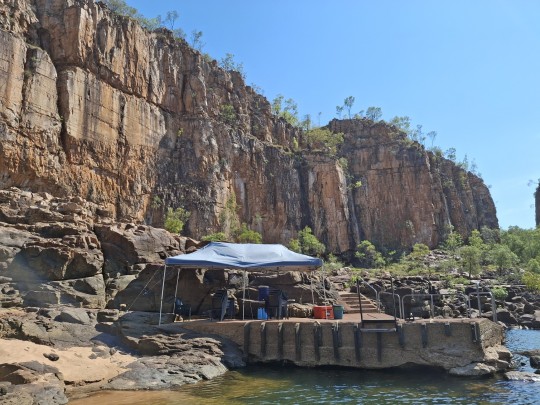


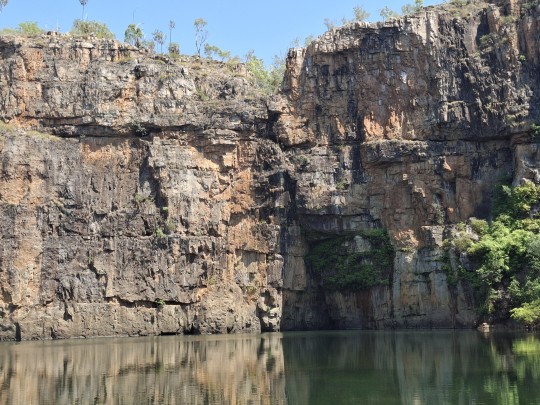

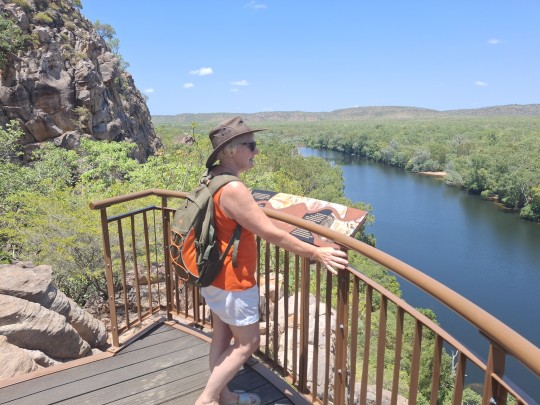
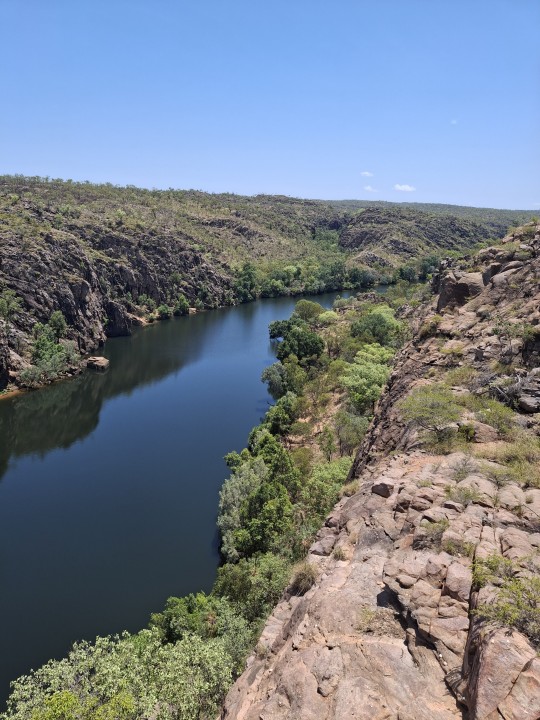

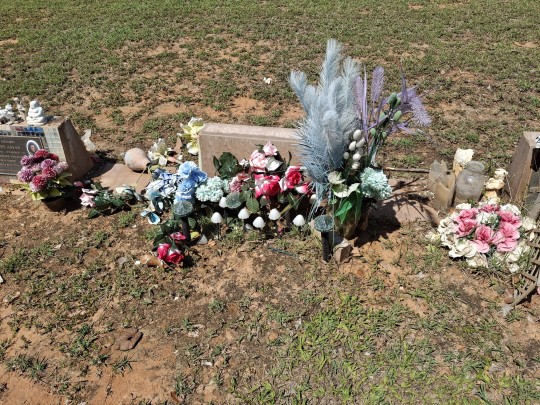
5 notes
·
View notes
Note
The geological time scale (GTS), as defined by international convention,[3] depicts the large spans of time from the beginning of the Earth to the present, and its divisions chronicle some definitive events of Earth history. Earth formed around 4.54 billion years ago, approximately one-third the age of the universe, by accretion from the solar nebula.[4][5][6] Volcanic outgassing probably created the primordial atmosphere and then the ocean, but the early atmosphere contained almost no oxygen. Much of the Earth was molten because of frequent collisions with other bodies which led to extreme volcanism. While the Earth was in its earliest stage (Early Earth), a giant impact collision with a planet-sized body named Theia is thought to have formed the Moon. Over time, the Earth cooled, causing the formation of a solid crust, and allowing liquid water on the surface.
The Hadean eon represents the time before a reliable (fossil) record of life; it began with the formation of the planet and ended 4.0 billion years ago. The following Archean and Proterozoic eons produced the beginnings of life on Earth and its earliest evolution. The succeeding eon is the Phanerozoic, divided into three eras: the Palaeozoic, an era of arthropods, fishes, and the first life on land; the Mesozoic, which spanned the rise, reign, and climactic extinction of the non-avian dinosaurs; and the Cenozoic, which saw the rise of mammals. Recognizable humans emerged at most 2 million years ago, a vanishingly small period on the geological scale.
The earliest undisputed evidence of life on Earth dates at least from 3.5 billion years ago,[7][8][9] during the Eoarchean Era, after a geological crust started to solidify following the earlier molten Hadean eon. There are microbial mat fossils such as stromatolites found in 3.48 billion-year-old sandstone discovered in Western Australia.[10][11][12] Other early physical evidence of a biogenic substance is graphite in 3.7 billion-year-old metasedimentary rocks discovered in southwestern Greenland[13] as well as "remains of biotic life" found in 4.1 billion-year-old rocks in Western Australia.[14][15] According to one of the researchers, "If life arose relatively quickly on Earth … then it could be common in the universe."[14]
Photosynthetic organisms appeared between 3.2 and 2.4 billion years ago and began enriching the atmosphere with oxygen. Life remained mostly small and microscopic until about 580 million years ago, when complex multicellular life arose, developed over time, and culminated in the Cambrian Explosion about 538.8 million years ago. This sudden diversification of life forms produced most of the major phyla known today, and divided the Proterozoic Eon from the Cambrian Period of the Paleozoic Era. It is estimated that 99 percent of all species that ever lived on Earth, over five billion,[16] have gone extinct.[17][18] Estimates on the number of Earth's current species range from 10 million to 14 million,[19] of which about 1.2 million are documented, but over 86 percent have not been described.[20]
The Earth's crust has constantly changed since its formation, as has life since its first appearance. Species continue to evolve, taking on new forms, splitting into daughter species, or going extinct in the face of ever-changing physical environments. The process of plate tectonics continues to shape the Earth's continents and oceans and the life they harbor.
I’m getting bad flashbacks of my high school years with this 🤠 but it’s very fascinating nonetheless- I especially love the part that uses fossils to analyse critical parts of history- all these years of evolution led to this right now like me drawing this fictional alcoholic man every day-
Would you still be user williamkisser if we met as Myllokunmingias millions of years ago…
if I hadn’t pursued the studies I’m currently doing I’d probably work in archaeology or an animal related job- I probably wouldn’t be drawing Jose as often-

#who am I kidding of course i would I’m already too far in#Jose already haunts my very being no matter what I major in#finally replying to your ask the day I receive it after the past hectic weeks-#apologies for the messy quick doodle- I wanted to reply to your asks with at least one doodle-#school biology made me want to pluck my eyes out
5 notes
·
View notes
Text
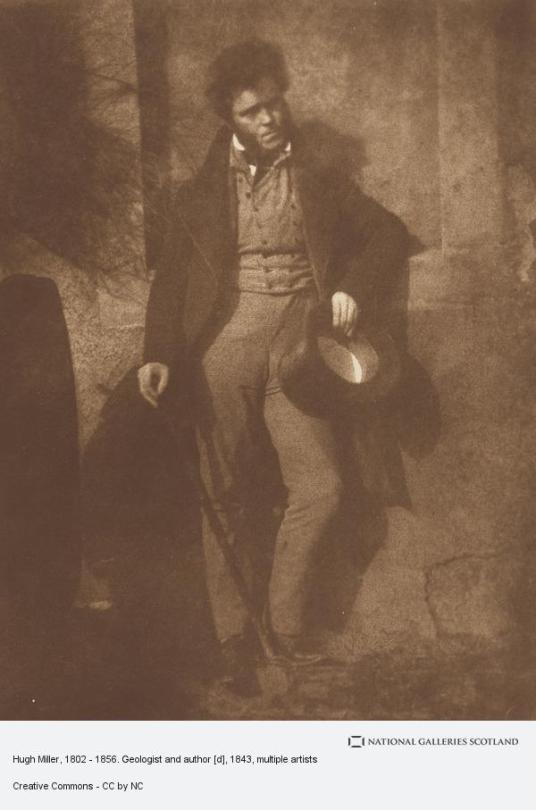


On December 24th 1856 the writer and geologist Hugh Miller “The Highlander who changed the world” died.
The death of Hugh Miller saddens me. On Christmas Eve, after reading some poems to his children and sending them to bed, Miller wrote a suicide note to his wife Lydia and shot a bullet through his chest, muffling the sound. Lydia discovered the body the next morning.
He may not be the best known Scot but Miller was a man of many talents, fossil hunter, folklorist, Christian, stonemason, geologist, newspaper editor, social justice campaigner, he was one of the great Scots of the 19th century.
Unlike other famous Scottish geologists like Hutton and Lyell, Miller was self taught.
Miller was orphaned after his father was lost at sea, he was educated at the local parish school and was said to have been an avid reader but also a habitual truant! After school he trained as a stone mason and it was while working in the quarries that his interest in geology began. He also started to write articles for the Inverness Courier. His book, Scenes and Legends of the North of Scotland is considered a classic, collected from the Cromarty firesides of friends and family it was inspired by two of Scotland’s literary greats Walter Scott and James Hogg.
Much of his writing was based upon his personal experiences of travelling around Scotland and northern England where he observed closely the homes and ways of life of Scottish crofters and the effects of the Highland Clearances. He also became heavily involved in religion and was involved in the fledgling days of the “Wee Free” editing their newspaper The Witness.
He also wrote on Geology and made many important original contributions to this field, discovering fossils of sea scorpions (eurypterids) from the Silurian, and fishes from the Old Red Sandstone (Devonian) rocks, on the coast near Cromarty, together with plants from the Devonian and Carboniferous periods.
His fish specimens proved of great interest to Louis Agassiz, the Swiss geologist who had become a world authority on fossil fishes. He also found many marine invertebrate fossils from the upper Jurassic rocks, also around Cromarty. Many of his fossils were drawn by him and presented in his Testimony of the Rocks, and in lectures that he gave to the Edinburgh Philosophical Institute,
His fossil collection of over 6,000 specimens formed the founding core of what is today’s Scottish national collection in the National Museums of Scotland.
For most of 1856, Miller suffered severe headaches and mental distress, and the most probable diagnosis is of psychotic depression. Victorian medicine did not help. He feared that he might harm his wife or children because of persecutory delusions.
Hugh Miller left the following note for his wife;
“Dearest Lydia, I must have walked, and a fearful dream rises upon me. I cannot bear the horrible thought. God and Father of the Lord Jesus Christ, have mercy upon me.”
Speculations about Miller’s reasons immediately rose. Upon request of his pastor, physicians conducted an examination of his brain, which showed a “diseased appearance.” The final judgment was that the suicide had been committed “under the impulse of insanity.”
He had not been well for a while. He had complained to his doctor that his brain was “giving way,” and had reported terrible nightmares that left him “trembling all over, and quite confused.” He had also reported sharp pains, like “an electric shock,” passing through his brain and leaving a burning sensation on top of his head. Because of these physical symptoms and the visible appearance of a “diseased brain,” some have suggested a brain tumour. Whatever it was, it was fairly sudden and unpredicted. As most illnesses of the brain, it was also largely unexplainable.
But people want explanations. Some blamed his mother, who told him stories about frightening Gaelic spirits. Some suggested he could not deal with the apparent contradictions between his faith and his geological studies. Interestingly, this second theory is still strong today. Yet, its proponents, like myself, don’t know Hugh Miller. He was never afraid of the truth, nor of the questions and challenges that led to its discovery.
In truth we will never know why he took his own life, like many suicides it is left unexplained, I suggest you have a look at the page below, “ The final days of Hugh Miller”
14 notes
·
View notes
Note
your actions have wronged me, I must have revenge.
“Hah!”
There’s a wolf in the henhouse.
“I’d like t’see you try, Needles.” Slowly but surely, he’s racking up all the points he needs to win this little game. Vash may have been sitting pretty on his 8-resource tile for a majority of the game, but Meryl rolling a lucky 7 just bought him a one-way ticket to sweet, sweet, victory. Naturally, she made the economical choice and placed the Robber on Vash’s major resource tile. That was enough to steal some of the wind out of blondie’s sails, but the Humanoid Typhoon’s fate was sealed the moment Wolfwood revealed his Knight card and put it into play.
Now, Vash’s defeat is all but assured. Seated cross-legged with one hand resting on top of his knee, Wolfwood leans forward to assess the current state of the board. He's practically grinning from ear to ear.
“Yeah, okay,” Meryl interjects through their staring contest with an audible groan. She tosses her cards out in front of her, effectively abandoning her position. “I forfeit. You guys can do whatever you want. Roberto, you can–”
“Waaay ahead of you, newbie,” Roberto drawls from behind an outcrop of sandstone on the other side of camp. The sound of the senior reporter’s voice briefly draws away Wolfwood’s attention, but he’s less impressed with the man’s lack of mental fortitude and more impressed that he managed to gracefully excuse himself from the game without anyone else noticing.
Where the hell did he even put his cards?
“Hey! Are you eating dinner without us?!”Jumping to her feet, Meryl stalks off from the firelight with her hands balled into tiny fists.
Back to more important things, then.
“So, what’re you gonna do, blondie?” Wolfwood leans back into a rising throne of rocks behind him (it’s not even that comfortable, but he probably looks way more smug draping his arms over the boulders) and breathes out a lazy plume of smoke through the open sliver of his smirk.
“Could beg for mercy.”
#sixty-billion#vash.#there's so many options for dumb it's hard to “settle” on just one 😭#and i'd do it again‚ beginning to end -- sixty-billion.
22 notes
·
View notes